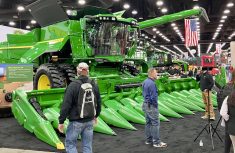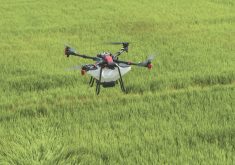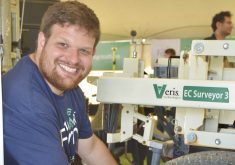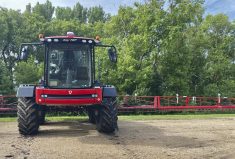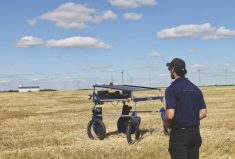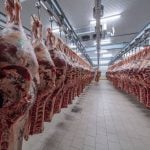In the 20-plus years of precision agriculture, most field jobs have evolved so they can incorporate some level of data retrieval, prescription mapping, overhead imagery, or specific in-field applications like auto-steer and downforce components.
But not all field jobs. Precision ag had seemed like it would also lead to site-specific weeding, but this never gained ground, due mostly to the development of herbicide resistance and the need for broadcast weed management as a standard practice.
Robotic weed control may be coming though, if Chuck Baresich continues working diligently towards that goal. In 2020, Baresich started testing autonomous robotic systems using the Raven OmniPower to spread fertilizer. In 2021, he and his team at Haggerty Creek Ltd. used Naio Technologies Oz autonomous robots for weed control trials in Brussels sprouts, celery, cauliflower and onions, along with strawberries and nursery stock.
Read Also

Knowledge lost and gained
How does a young animal learn to hunt? By observing the older generation. Humans are much the same. As a…
Baresich chose horticulture and berries since high-value crops generally require more labour but also because there are limited weed control options other than physically removing the weeds.
“The other reason why it works (with hort crops) is that field sizes tend to be smaller and they’re better prepared in terms of soil conditions,” says Baresich, general manager with Haggerty Creek. “Essentially, the autonomous robots are self-propelled cultivators but they’re not cultivating deep, just brushing the surface.”
Weed management using robotics follows the same principle as any other method. To be effective, you have to get to the weeds when they’re small, before they can develop a deep root.
“What the autonomous robot lets you do — and one of the reasons why they’re going to take off — is weed more often because farmers tend to wait as long as they can and try to get as many weeds up,” says Baresich. “Since it’s so costly to hand-weed or cultivate, they won’t do it as often as they should. But an autonomous system lets you weed regularly, like once a week.”
It might seem more costly to use a robot compared to sending in a crew to manually weed a field (in horticultural crops, at least), but not if the robot is weeding six times during the summer, which it can. That’s why the use of robots has to be considered from a cost and efficacy perspective.
Early in 2021, Baresich worked with the Ontario Ministry of Agriculture, Food and Rural Affairs, the University of Guelph’s Ridgetown Campus and the Holland Marsh Growers’ Association to help create the “Autonomous Working Group.” That collective set priorities and direction, along with which crops they wanted to test.
It keeps going…
The units tested by Baresich are battery operated and will run seven to 10 hours on a charge. The larger unit that Baresich used in 2021 — roughly the size of a Mini Cooper car — is designed to weed 10 acres per day, so that would go into a 50-acre field.
“You can’t always go every day, so over a seven-day period we believe it would do 50 acres and then start over again,” he says. “The smaller Oz robots are designed for a five- to 10-acre field, so they’re for more of a market garden operation.”

Although they’re being tested in horticulture crops, Baresich believes there will come a day when these robotic units are used in row crops.
“In wider-scale field crops, there’ll be a hybrid approach where people might do a burn-down application like they’ve always done, then go in with the robots and use AI systems to do targeted weeding,” he adds. “You might say, ‘I want the robot to get horse nettle or Canada fleabane or waterhemp’. The robot isn’t being challenged to do 200,000 plants per acre so that would increase the speed.”
That technology is in its infancy and Baresich is working with the Small Robot Company from the U.K., which has designed a system that targets weeds in crops such as winter wheat. It maps out the weeds then inputs them into an AI system named Wilma, which then alerts the agronomist who can identify which weeds are the issue.
“Then the robot goes through and uses electricity to ‘zap’ weeds in the field,” he says. “It can do that at a much faster rate and handle no-till or reduced-tillage situations because it’s not dragging a cultivator through the trash.”
Another company Baresich has been talking to is Carbon Robotics which uses lasers to do the same thing. It’s more focused on horticulture crops whereas the Small Robot Company is looking at traditional field crops. Baresich notes the Small Robot Company is promoting its robot design as one that can handle a 50-acre field, requiring two or three of the weeding robots to get the desired capacity.
A Canadian company, Nexus Robotics, is taking a different approach, using mechanical “fingers” as well as computer vision to identify non-desirable plants, pulling them out and depositing them in the centre of the row. The Nexus GOAT will be field tested by Baresich in 2022.
The value statement with autonomous field technology is the absence of emotional ties in decision-making. A robot doesn’t need to weed a field in a set time period nor does it have prior commitments. It doesn’t have to prepare dinner or do any bookwork. The only thing it has to do is weed a field, and it will do that in 37 C heat and humidity, without getting tired or thirsty.
“This is part of rethinking the workflow and rethinking how we’re doing this,” says Baresich. “We don’t need to cultivate the whole field in one day.”
Change is coming
If there is a significant challenge with using these autonomous systems it’s the degree of change that comes with the technology. Using robots in the field is definitely something new and farmers would need to be persuaded it’s worth the time and effort to learn.
Connectivity is another hurdle to successfully incorporating these robots. Cellular connectivity and good RTK signals are vital. All of these systems require good access to the internet — for monitoring and for safety.
“General field conditions can be a challenge, for instance how much tillage was done and how smooth are the fields,” says Baresich. “Residual trash can also cause a problem. These robots were mostly designed in Europe and their production systems are quite different from what we do here, where they have no trash on their soils.”

Yet another barrier to overcome is trying to understand how the work flow may change. Baresich wanted to cover off how to get the robots to the field, but also who looks after them, how they will be deployed and recharged, and how they can be washed and cleaned. That’s an underrated step since growers want to avoid moving nematodes or weed seeds from one field to another.
Yet, robotics is nothing new
If there’s a positive to the evolution and adoption of robotics, it’s that the process has already begun. Consider the acceptance of robotic milkers by the dairy industry. They took a very specific part of the producer’s life and automated the milking part. Similarly in field crops, the industry needs to ask which pieces can be automated.
“Now we’re saying, ‘What is the next piece we can automate?’” says Baresich. “We’re testing the only Raven OmniDrive this fall that’s here in Eastern Canada, and that’s the autonomous grain buggy. We’re automating a specific task or component of harvest, driving the buggy up and down the field, not automating the corn harvest.”
It’s not a matter of getting rid of machinery operators either, but of accelerating the knowledge transfer that goes with advanced training on the farm while increasing efficiency. It frees up managers and growers to do more of what they’re good at — farming.
“Sitting in the seat of the tractor doesn’t necessarily make you the farmer,” notes Baresich. “Nor does having your hand on the hoe. Choosing productive and sustainable uses for your land assets makes you the farmer. The robots can’t do what a human can do. Humans don’t give themselves credit for how smart we are.
“What I encourage for success is to look at the jobs we’re doing and break them up into small tasks, and ask which task or component of what I’m doing can I use an autonomous machine to simplify or improve.”
Change will come, says Baresich. “It’s probably very similar to when the first tractor showed up on farms, and some people said, ‘It’ll never replace the horse’. We really are at that stage in the autonomous ag field.”




